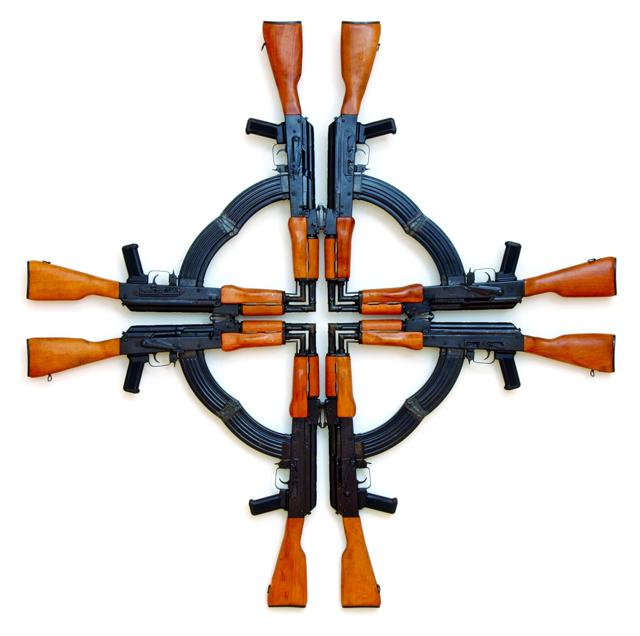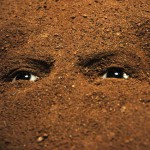- “Cross for the Unforgiven” Courtesy of Asheville Art Museum
- “Elementary Object” (detail) Courtesy of Asheville Art Museum
- Detail from “Loom” from Do Not Ask Me, courtesy of Station Museum of Contemporary Art. Photo by John Lucas
“All contemporary art conversation is about contemporary culture,” says artist Mel Chin. “That conversation is not complete without talking about sports.” He’s referring to “Growth of the New Gods” — the massive grapevine of basketballs and leaf-shaped hoop-netting that festoons the Asheville Art Museum’s façade on the Biltmore Avenue side. The bright orange globes are an unexpected sight for passersby, and signal the arrival of Chin’s anticipated Asheville exhibition, High, Low and In Between, on display at the museum through Nov. 25.
The basketball grapevine is an Asheville variation of Chin’s 2011 “Temple of the New Gods,” wherein the postmodern foliage covered the Greek revival façade of the Nave Museum in Victoria, Texas. The installation illustrates the loaded symbols and dry wit conveyed in many of Chin’s sculptures.
"We're talking about gods; we're talking about the primacy of sports figures in terms of people we listen to,” says Chin. “And they are superhuman in their prowess and capital."
Born to Chinese immigrants in Texas, Chin grew up in Houston and currently lives in Burnsville, N.C. Over the last 40-plus years, he has developed a number of projects that would be impossible to contain within the walls of a museum, such as his ongoing project Operation Paydirt. The large community endeavor aims to collect 300 million hand-drawn interpretations of the U.S. $100 bill — dubbed “Fundreds” — to be delivered to Congress in exchange for $300 million, the estimated cost of cleaning lead-contaminated soil in New Orleans, according to the project's website, http://www.fundred.org.
“I still believe art is a catalytic structure that actually forms a place for discourse, or even a place for language to be created,” says Chin.
Most astounding is the array of materials and forums Chin has accessed in his art work. His 2001 project, S.P.A.W.N., facilitated the development of earthworm farms in the basements of burned and abandoned homes in Detroit (the acronym stands for Special Project: Agriculture, Worms, Neighbors).
“Revivial Field,” built on a landfill in St. Paul, Minn., incorporates hyperaccumulators — plants that absorb heavy metals and other toxins in soil.
When asked if all of his work is politically motivated, Chin responds, “To be honest, you can’t open your mind or be in this world without being politically based. Inaction is equivalent to action itself. If someone wanted to make those distinctions they can, but in my mind, I don’t.”
Updating the image context
Visitors to the Asheville Art Museum have the opportunity to see a sample of Chin’s more material pursuits. The largest component of the exhibition is “The Funk & Wag, from A to Z,” a monumental endeavor of 524 collages that cover the walls of the museum’s East Wing gallery. Each collage was hung with scrupulous care by two of the museum’s art handlers, and the piece took nearly three days to install.
Entering the gallery brings to mind the hushed reverence of an old library, except here the books’ contents are on display. To prepare the collages, Chin had every image excised from the complete collection (25 volumes) of a 1953 edition of Funk & Wagnall’s Universal Standard Encyclopedia, once regarded as the ultimate resource of knowledge and information.
Not only is the overall presentation striking, but each collage offers a poetic investigation of Chin’s creative mind; this just might be one of Chin’s most personal pieces to date. Formally there is a lot to study, like Chin’s restrained compositional style and the use of paper as a medium, whether it’s woven together, assembled into a nest, torn or hole-punched.
Many of the collages are quite witty: the owl with bat-like wings made of buildings, or the robotic lizard-like creature. No doubt everyone will draw their own conclusions of what each piece means, and for those who want guidance, a title catalogue is available, which reads as a book of poems on its own. “Arch Rivals,” a collage composed with aqueduct arches, is probably funnier with the title, but the entire collection is just as good without the wordy references.
It becomes clear after looking through the collages that, in 1953, encyclopedias contained a disproportionate amount of images of white-male thinkers, architecture and animals. So Chin has achieved a major feat: he has liberated the antiquated knowledge that upholds a paternal, Euro-centric outlook on the world. Here, a viewer’s subjective mind is free to roam. “The visual information in these 1950’s sets were contextualized by texts that may be outmoded today… [’Funk & Wag’] is an upgraded, or updated, re-contextualization of all the images,” says Chin. “It’s a new life.”
An essential element of Funk & Wag is an unassuming circular bookshelf that references Queen Anne furniture (“My least favorite furniture style of all time,” says Chin). The bookcase is specially designed to accommodate the remains of the hardbound encyclopedias, which, after their vivisections, close into wedge-like forms. The shelf holds them in rounded unison like slices of a pie. A portion of the case encapsulates the remaining shreds of paper behind glass, so that no part of the book was actually thrown away. “If you wanted to, you could unglue every collage and you could reconstruct the entire encyclopedia set,” says Chin. “No book was destroyed in the making of this [artwork].”
Hillbilly armor
Themes of war and institutionalized violence have weighed heavily in Chin’s work throughout the years, as two sculptures at the museum exemplify. One, the “Cross for the Unforgiven,” is an elegant configuration of AK-47 assault rifles welded into the Maltese cross of the Crusades, and serves as a reminder of a long history of conflict in the Middle East.
The other, “Terrapene Carolina (Hillbilly Armor),” is a re-creation of armor in the shape of a turtle’s plastron as the underbelly of a U.S. Army Humvee. It is constructed out of rubble gathered from Tennessee and North Carolina: a block of concrete, a tin roof, windows from a schoolhouse, a compacted shopping cart, the side of a trailer. The varied surfaces of debris suggest the assorted histories of individuals sent into battle.
The sculpture is a response to Donald Rumsfield’s 2004 comment, “You go to war with the army you have,” directed at U.S. soldiers dissatisfied by the lack of armor on their Humvees. To up-armor their vehicles, soldiers scavenged landfills in Tennessee for pieces of scrap metal and bulletproof glass to bolt to their Humvees as added protection against roadside bombs in Iraq. They called it "hillbilly armor.”
The exhibit’s title, High, Low and In Between, references a song by the late Texas musician Townes Van Zandt, a lifelong friend of Chin’s. “The highs are humor, expression, life, love and all that,” says Chin. “The lows are death, war, destruction, depression, solitude. Sometimes the high can be solitude; they’re permeable by definition. But everything in between is the funk and wag.”
— Ursula Gullow writes about art for Mountain Xpress. See her work at http://ursulagullow.com.
what: Mel Chin: High, Low and In Between
where: Asheville Art Museum
when: On view through Nov. 25 (Details and associated events at ashevilleart.org)
Image credits: Mel Chin, Cross for the Unforgiven, 2002, AK-47 assault rifles (cut and welded), 59 x 59 x 1.5 inches. Image Courtesy of Station Museum of Contemporary Art. Photo by John Lucas. Mel Chin’s The Elementary Object, 1993, Corsican briarwood, steel, plastic, concrete/vermiculite, excelsior packing material, flannel, paper tag, fuse cord, triple F blasting powder. 3 1/2 x 12 1/2 x 10 1/4 inches. Multiple of 13. Image courtesy of Mel Chin.






Before you comment
The comments section is here to provide a platform for civil dialogue on the issues we face together as a local community. Xpress is committed to offering this platform for all voices, but when the tone of the discussion gets nasty or strays off topic, we believe many people choose not to participate. Xpress editors are determined to moderate comments to ensure a constructive interchange is maintained. All comments judged not to be in keeping with the spirit of civil discourse will be removed and repeat violators will be banned. See here for our terms of service. Thank you for being part of this effort to promote respectful discussion.